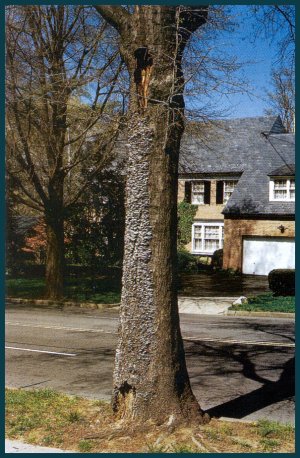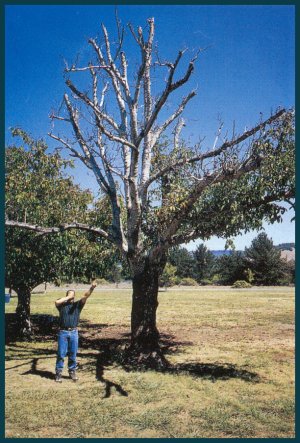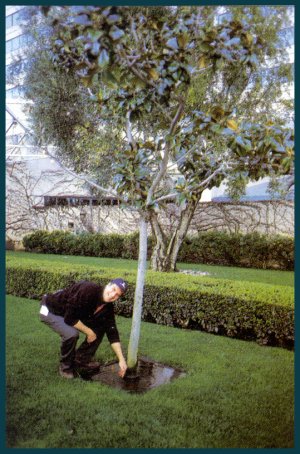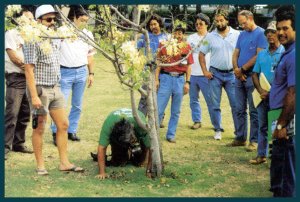Tree Education and Philosophy
By Alex L. Shigo
 An
educated homeowner would probably recognize the potential high risk of
failure of such a tree, and have something done about it. It is the
responsibility of tree care professionals to help educate customers about
the care of their trees.
An
educated homeowner would probably recognize the potential high risk of
failure of such a tree, and have something done about it. It is the
responsibility of tree care professionals to help educate customers about
the care of their trees.
Humpty Dumpty said a word means only what he wants it to mean.
Socrates, a great philosopher, said, just tell us what you want your word
to mean. And Voltaire, another great thinker, said, when we know
what you mean by your words, arguments and misunderstandings will seldom
happen. So be it.
Just the facts
Philosophy is a delightful trip around a circle. Philosophy is
about thinking.
Thinking is a mental process where experiences, old thoughts
and ideas, facts and other stored information are connected in ways that
result in some new thought or idea.
Trees are superior survival organisms. They live longer, grow
taller and become more massive than any organism ever to inhabit earth.
Trees do demand some respect. This means trees have dignity.
Education is a learning process. Learning leads to increased
knowledge. Knowledge is the amount of information gained. Intelligence
is the capacity to gain information. Wisdom is the use of information in
ways that ensure continued high - quality survival.
My objective in this brief essay is to focus on tree education:
what it is, what it can do for you and what it can do for trees.
 Stress? Or,
treatments done without understanding some simple basics of biology?
The tree was over - pruned, over - trenched, and over - fertilized.
The bill was "over," also.
Stress? Or,
treatments done without understanding some simple basics of biology?
The tree was over - pruned, over - trenched, and over - fertilized.
The bill was "over," also.
Training and educating
Trees are beginning to receive some respect worldwide. Not much, but
some, and that is better than the way it was in the past. Now, I believe,
it is the responsibility of people who care for trees, and about trees,
to keep this movement going. The more you learn about any subject,
the better the chances are for regulating the direction of the subject
or if that is not possible, then for predicting with high probabilities
the way it will go.
Training to deal with trees has far exceeded education about trees.
Training is wonderful. However, training without educating leads
to robots. At the same time, education alone leads to waste.
Training and educating are twins; both are needed. Now!
Some people are using the words "education about trees," but
I don't know what they mean.
Teachers teach. They try to get the mental "engines" started. They
stimulate you.
 The grass
is very green. The tree is dying! If trees are wanted on such a site,
they should be species that can tolerate lots of water .
The grass
is very green. The tree is dying! If trees are wanted on such a site,
they should be species that can tolerate lots of water .
To keep the "engines" going, students must be disciplined enough
to keep adding more information to the mind. The adding process is
motivation. Think of your car. The key connects the battery
and starter. Once the engine turns over, it begins to run on gasoline.
Teachers are batteries. Gasoline, or self -discipline, keeps the
system going - motivation.
Why do you need to know this stuff? Because decision making
in the field is the "name of the game." People who can make more
correct decisions faster have a better chance for higher quality survival.
To lecture from the stage about trees and treatments is easy. When
you are outside with the trees, it is not so easy. There are always
some complicating constraints such as time, schedules, weather, personal
health, breakdowns, regulations, complaining customers and the list goes
on and on. You never know what you will face until you are out there.
Still, you must make some decisions and do the job, or you will soon be
out of a job.
An Example: Stress
Trees are living systems. Every living system will do something
when its survival is threatened. Trees are systems that came from
genetic codes. The systems do have limits. When any agent causes
the system to operate near its limits, then the system becomes stressed.
When the potential survival - threatening agent continues to exert a force,
then the tree system could go from stress to strain. Any system is
threatened when it is forced to operate near its limits. When the
threatening force is continued, the likelihood of the system stopping increases.
In nature, there are two major types of stress. The most life
- threatening type deals with the second law of energy flow. The
law states that every system must have a continuous supply of energy to
remain in an orderly state - healthy. As energy input decreases,
the likelihood of operating near the limits increases. Call it primary
stress. Because trees are living systems, they must maintain a continuous
flow of energy. Trees burn glucose to release energy to power the
forces of life. This is the same for humans and other life forms.
When energy begins to become limiting, the system begins to operate near
its genetically designed limits.
There is no known way to feed a tree in the sense of adding an energy
source. Food is a substance made up of elements essential for life
and an energy source. Animals can be fed. Trees get their energy
by a process that traps the energy of the sun in a molecule called glucose.
Glucose is made as chlorophyll is stimulated to form ATPs that later power
the formation of glucose.
The process of trapping the sun' s energy is called photosynthesis.
When the process does produce glucose, some is used for metabolism, some
for structural parts and some for storage.
The stored energy is in a form not soluble in water; either as starch,
oils or fats. The stored energy is used to start new growth when
the next growth cycle starts and for defense. When stored energy
reserves are low, defense is low.
So, what can be done when a tree is energy stressed?
You cannot feed it. If you add fertilizer (which is not food), the
nitrogen will cause the already low supply of energy reserves to be lowered
all the more as the nitrogen combines with the stored carbon to form amino
acids that, in turn, lead to increased growth. The new growth will
be defenseless. And the insects and microorganisms apparently can detect
this. They attack.
The story goes on. There is much more, but my point here is
to show how one of the major problems facing trees - stress - depends on
education. The simple answers today deal with adding all kinds of
stuff that may give the illusion of short - term benefits. In the end,
I believe, many of these treatments may add to the problem.
Before I leave the subject of stress, I should say that secondary
stress is caused when substances and conditions essential for life are
at extremes; too little, too much. These secondary stress problems
can usually be treated by adjustments of substances and conditions.
 Where are
the roots? They were buried at about a foot below ground level. Education
starts when people begin to touch and see things for themselves.
Where are
the roots? They were buried at about a foot below ground level. Education
starts when people begin to touch and see things for themselves.
Education is the key
Stress is used here only as an example of why education about tree biology
is so important. Of course, much more needs to be given about the
subject of tree stress. But, for now, here are some brief comments
about what should be done. First aid for stress means keeping the
tree safe and stopping the stress agents. Keeping it safe could mean
removing the target, bracing the tree, or removing parts or the entire
tree. Before you can reduce or stop the agents or conditions causing
the stress, you must know what they are. Tree biology again.
After first aid, start a long - range program of correct tree care
that includes mulching, pruning, watering, fertilizing and probably much
more. Decisions for all treatments, especially for dose, should be
based on a sound understanding of tree biology.
Trees do have dignity. They should get more respect.
Respect starts with an attempt to understand. Understanding is about education.
So, maybe we are back to the beginning ...A trip around a circle. Is that
philosophy?
“An author,
lecturer and consultant, Dr. Shigo started
Shigo and Trees, Associates
twenty
years ago after retirement from the U.S. Forest Service.”Reproduced with permission of Tree Care Industry and Dr. Alex
L. Shigo.
The article was published in Volume XI, Number 6 - JUNE 2000 of
TCI.
This site is dedicated to the remembrance of Robert Felix who
for many years worked very hard for the improvement of the tree care industry: 1934-1996.
Back to Articles.
Dictionary MAIN
PAGE
Text & Graphics Copyright © 2009
Keslick & Son Modern Arboriculture
Please report web site problems, comments and words of interest,
not found.
Contact
 An
educated homeowner would probably recognize the potential high risk of
failure of such a tree, and have something done about it. It is the
responsibility of tree care professionals to help educate customers about
the care of their trees.
An
educated homeowner would probably recognize the potential high risk of
failure of such a tree, and have something done about it. It is the
responsibility of tree care professionals to help educate customers about
the care of their trees. An
educated homeowner would probably recognize the potential high risk of
failure of such a tree, and have something done about it. It is the
responsibility of tree care professionals to help educate customers about
the care of their trees.
An
educated homeowner would probably recognize the potential high risk of
failure of such a tree, and have something done about it. It is the
responsibility of tree care professionals to help educate customers about
the care of their trees. Stress? Or,
treatments done without understanding some simple basics of biology?
The tree was over - pruned, over - trenched, and over - fertilized.
The bill was "over," also.
Stress? Or,
treatments done without understanding some simple basics of biology?
The tree was over - pruned, over - trenched, and over - fertilized.
The bill was "over," also.
 The grass
is very green. The tree is dying! If trees are wanted on such a site,
they should be species that can tolerate lots of water .
The grass
is very green. The tree is dying! If trees are wanted on such a site,
they should be species that can tolerate lots of water .
 Where are
the roots? They were buried at about a foot below ground level. Education
starts when people begin to touch and see things for themselves.
Where are
the roots? They were buried at about a foot below ground level. Education
starts when people begin to touch and see things for themselves.